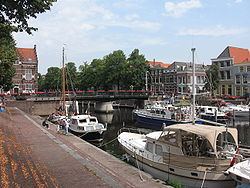Country Netherlands Demonym(s) Gorkumer Postcode 4200–4208 Area code 0183 | Elevation 2 m (7 ft) Time zone CET (UTC+1) Website www.gorinchem.nl | |
 | ||
Weather 8°C, Wind W at 11 km/h, 81% Humidity Points of interest Dalempoort, Rijdend Unifil Museum, Wilhelmina Fontein, Duveltjesgracht, Hugo De Groot Poortje | ||
Gorinchem ( [ˈɣɔrɪnˌxɛm]), also called Gorkum ([ˈɣɔrkɵm] or [ˈɣɔrkəm]), is a city and municipality in the western Netherlands, in the province of South Holland. The municipality covers an area of 21.93 km2 (8.47 sq mi) of which 3.01 km2 (1.16 sq mi) is water. It had a population of 35,271 in 2014.
Contents
- Map of Gorinchem Netherlands
- History
- Notable natives and residents
- Transport
- International relations
- References
Map of Gorinchem, Netherlands
The municipality of Gorinchem also includes the population centre of Dalem.
History
It is assumed that Gorinchem was founded circa the year 1000 by fishermen and farmers on the raised land near the mouth of the river Linge at the Merwede. "Goriks Heem" is first mentioned in a document from 1224 in which Floris IV granted people from Gorinchem exemption of toll payments throughout Holland.
Somewhere between 1247 and 1267, Gorinchem became property of the Lords of Arkel. At the end of the 13th century earthen mounts reinforced with palisades were built around the settlement to protect it from domination by the neighboring counties of Holland and Gelre. Half a century later real city walls were built complete with 7 gates and 23 watchtowers. Otto van Arkel granted it city rights on 11 November 1322.
Jan van Arkel had a dispute with Albert I, brother of Willem V of Holland, leading to war and subsequently to the annexation of Gorinchem to Holland in 1417. This resulted in increased trade and Gorinchem grew to be the eighth city of Holland.
On 9 July 1572, the Watergeuzen (Dutch rebels against Spanish rule) conquered the city and captured 19 Catholic priests and monks. Because they refused to renounce their faith, these priests and monks were brought to Brielle where they were hanged and were from then on known among Catholics as the Martyrs of Gorkum.
In the 16th century the city walls were so deteriorated that they were replaced with new fortifications and eleven bastions, which still are almost completely intact. The new walls were rounded off in 1609 and were placed farther from the town centre, making the city twice as large. In 1673 Gorinchem became part of the old Dutch Water Line.
The city walls had four city gates: the Arkel Gate in the north, the Dalem Gate in the east, the Water Gate in the south (where the ferry to Woudrichem was), and the Kansel Gate in the west. Of these four gates only the Dalem Gate remains. The others were removed in the 19th century to make way for vehicular traffic. A portion of the Water Gate was preserved in the gardens of the Rijksmuseum in Amsterdam.
In the 18th century, the economy went into decline. After the French domination, the retreating French troops took station in the bastion fortress of Gorinchem. After a three-month siege they capitulated but the city was heavily damaged.
During the Industrial Revolution, Gorinchem recovered. Increased shipping led to new canals being dug and a railway connection to the city. Its population quickly rose, filling the innercity and new neighbourhoods had to be built outside the city walls.
At the beginning of the 20th century, expansion took place in the Lingewijk and West neighbourhoods. After World War II, expansion started in the north-western portion of the municipality which was completed in the 1970s. This was followed by developments in the east of the neighbourhoods Wijdschild and Laag Dalem. In 1986, the town Dalem was added to the municipality.
Notable natives and residents
Transport
The city is crossed by two motorways; the A15 on the northside, and the A27 on the westside.
The city also has a railway station: Gorinchem.
